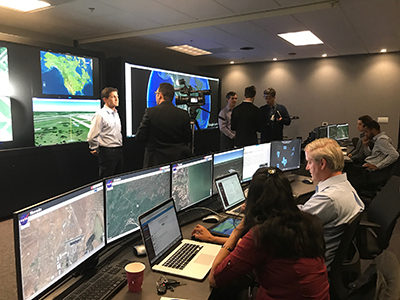There are tons of exciting concepts associated with drone technology, but few are as transformative as a UAS traffic management (UTM) system. With more and more people taking to the sky, drone operators will need to have a better understanding of what’s happening around them. Enabling that kind of awareness is just the beginning of what UTMs will mean for commercial operators though.

Parimal Kopardekar – better known as PK. Images courtesy of NASA.gov
The logistics around what it will mean to create this kind of system is exactly what Dr. Parimal Kopardekar (better known as PK) will be exploring as the chair of the upcoming
UTM Plenary session at the
Commercial UAV Expo. As the principal investigator for UTM at NASA and a
true thought leader in this space, PK is unquestionably the ideal person to lead this discussion.
As a primer to that session, I wanted to talk through some of the topics and concepts that will be referenced and further explored at the Expo. In the interview below, PK was kind enough to explain why NASA has been so involved with this technology, how organizations around the world are working on it, how NASA is working with the FAA and plenty more.
Jeremiah Karpowicz: Before we dig all the way into where things are with the UTM system you’re working on, I wanted to first establish why NASA is developing it. I understand that the first “A” in “NASA” stands for aeronautics, but does the administration’s dedication to seeing this system created go deeper than that? PK: NASA Aeronautics has been conducting research and development activities related to airspace operations for over 25 years. Our team’s passion is about improving the current operations and enabling the future. The UTM concept was originated at NASA, but quickly supported by industry, in close collaboration FAA, and now even adopted by ICAO. NASA does not develop operational systems but conducts critical research and development that defines the system requirements and operational methods. The collaboration with the FAA is crucial to ensure the technology transfer occurs and we co-lead the UTM construct design. The partnership with industry is also highly critical since we leverage industry’s capabilities and accelerate the research.
Jeremiah Karpowicz: This is a concept you’ve been working on now for a number of years, and I wanted to find out whether or not your approach to it has changed or evolved over that time. Do you find yourself still talking about the concept in the same way as you did in 2015? PK: Yes, basically we are still referring to the concept in the same manner. We have made subtle changes (e.g., planned area of operation vs reservation of airspace) for each operator. Also, we let each country decide the best way to adopt the UTM instantiation. We have envisioned from country-level ANSP (Air Navigation Service Provider) to a localized (but connected) UTM environment. Further, the entity who offers the services (e.g., flight planning, weather, etc) are decided by each country. In some cases, ANSP will offer, in others industry, and third hybrid approach.
Jeremiah Karpowicz: Is it beneficial or useful to think of this system as “air traffic control for drones”? PK: It’s more like management. In manned aviation, an air traffic controller has to approve any and every change to the flight including initiation. The air traffic controller ensures safe operations – detects and resolves conflicts, and keeps clear of other constraints. In the case of UTM, it’s more like, “give me an idea of constraints and other operations”, and an operator takes responsibilities to stay clear. In one case, you get complete help in directions; in the other case you get information (electronically) telling you what not to do and you figure out how to meet the constraints and your business objectives
Jeremiah Karpowicz: Perhaps I’m alone in this, but I find myself a little confused when reading stories about a certain company or organization deploying UTM technology. Is “UTM” a generic term that a variety of people use, or when we see that term, will NASA always be involved, regardless of whether or not the agency is specifically mentioned? PK: If you look at the UTM architecture – there are three entities – air navigation system provider (FAA in the USA), UAS operator, and UAS service supplier (USS). In some cases, UAS operator and USS may be same entity, and in other cases two separate entities. The USS provides services such as flight planning, communication, tracking, etc. In most cases when they refer to UTM technology – they refer to USS. There is a room for multiple USS interacting with each other to maintain safety of multiple operations.
Jeremiah Karpowicz: It’s equally amazing and impressive how often your name comes up whenever this topic is discussed. It happens whether I’m talking with someone in the United States or Europe. Can you tell us about your efforts to work with drone organizations in the United States to ensure this system is something that can make sense for them from a practical perspective? PK: I just got lucky and I am quite humbled by the publicity. It’s all about our wonderful NASA team and partners who are making UTM R&D happen. Further, NASA Aeronautics Research Mission Directorate and Airspace Operations Program management at headquarters, locally at Ames, Langley, Armstrong, and Glenn deserve a lot of credit for supporting the idea and seeing its potential in the early stages.
We are working with over 200 collaborators to various levels – some only participate in working groups to define requirements, some develop USS capabilities, some provide vehicles, others participate in flight tests, and some do all. It’s truly collaborative innovation.

UTM researchers being interviewed in the UTM Lab at Ames Research Center.
PK: Entities such as ICAO and GUTMA help harmonize the concepts and requirements. This is useful to US companies who want to do business outside. When they want to operate outside, it’s valuable for them that operational practices are similar outside US. This helps them be global entities. It helps everyone.
Jeremiah Karpowicz: Can you tell us about how NASA is or isn’t working with the FAA in the creation of this system? PK: NASA and FAA are working hand and glove together in developing the concept and UTM system requirements. We collaborate through Research Transition Team and FAA has assigned over dozen folks to the RTT which has been very valuable as they bring in operational perspectives and interoperability with current operations. Many folks in the FAA deserve credit for setting up and executing a valuable collaboration mechanism.
We are also working with FAA test sites to ensure validation of concepts. The collaboration with FAA’s test sites has been critical to test capabilities in diverse use cases and environment.
Jeremiah Karpowicz: What are the biggest challenges that you’re currently working through? Are they more about the technology or about trying to work with and integrate into existing systems and technologies? PK: Currently, we are focused on interoperability of manned and unmanned operations. Our next interesting area is urban area where safety, security, and location-based contingencies are critical. We want to create concept, construct and requirements for a UTM system that will safely enable high density UAS operations in low altitude in the presence of urban constraints (e.g., GPS degradation, tall buildings, wind effects due to buildings) as well as security related considerations while ensuring local, regional, and federal operational practices and rules.
Jeremiah Karpowicz: I’ve watched a number of presentations that you’ve given at industry events, and you often talk about your four capability levels while laying out a timetable for each. Can you talk a bit about the stages you’ve worked through so far and whether the timetable around completion is still accurate? PK: We have four technical capability levels (TCL) – first focused on multiple operators vehicles coordinating with each other to stay clear of each others area of operation, second focuses on BVLOS with accurate tracking and alerts for off-nominal conditions, third focuses on interoperability among manned and unmanned operations to stay clear with each other, and fourth focuses on urban airspace. We have studies first two, and entering into third TCL explorations working closely with test sites.
TCL4 is indeed planned for 2019.
Jeremiah Karpowicz: What would you say to anyone who doesn’t believe the industry is ready to support this kind of system, either on a technical or financial level? PK: I don’t know anyone that does not believe. I see US and global adoption of this concept. We have seen adoption by many other countries.
Stay up to date with the latest UTM developments from NASA via their very active Facebook and Twitter pages, and see what else PK has to say about the supporting technologies associated with the development of a UTM system at the Commercial UAV Expo.

















Comments